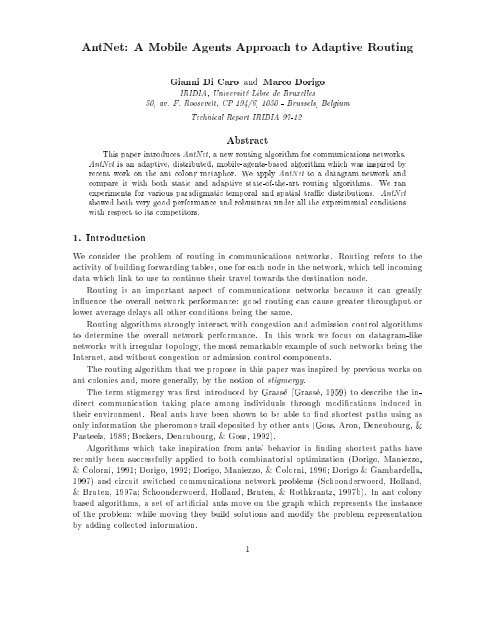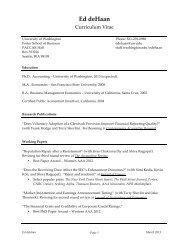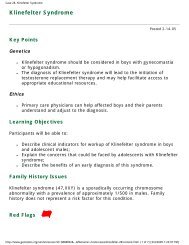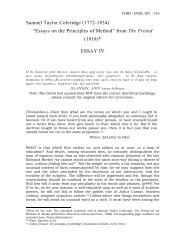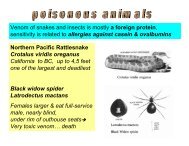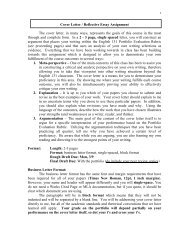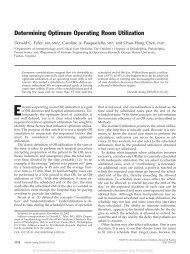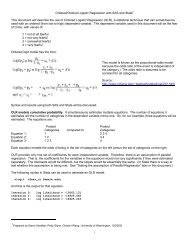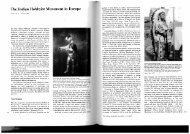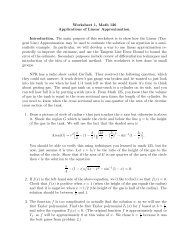AntNet: A Mobile Agents Approach to Adaptive Routing
AntNet: A Mobile Agents Approach to Adaptive Routing
AntNet: A Mobile Agents Approach to Adaptive Routing
Create successful ePaper yourself
Turn your PDF publications into a flip-book with our unique Google optimized e-Paper software.
<strong>AntNet</strong>: A <strong>Mobile</strong> <strong>Agents</strong> <strong>Approach</strong> <strong>to</strong> <strong>Adaptive</strong> <strong>Routing</strong><br />
Gianni Di Caro and Marco Dorigo<br />
IRIDIA, Universite Libre de Bruxelles<br />
50, av. F. Roosevelt, CP 194/6, 1050 - Brussels, Belgium<br />
Technical Report IRIDIA 97-12<br />
Abstract<br />
This paper introduces <strong>AntNet</strong>, a new routing algorithm for communications networks.<br />
<strong>AntNet</strong> is an adaptive, distributed, mobile-agents-based algorithm which was inspired by<br />
recent work on the ant colony metaphor. We apply <strong>AntNet</strong> <strong>to</strong> a datagram network and<br />
compare it with both static and adaptive state-of-the-art routing algorithms. We ran<br />
experiments for various paradigmatic temporal and spatial trac distributions. <strong>AntNet</strong><br />
showed both very good performance and robustness under all the experimental conditions<br />
with respect <strong>to</strong> its competi<strong>to</strong>rs.<br />
1. Introduction<br />
We consider the problem of routing in communications networks. <strong>Routing</strong> refers <strong>to</strong> the<br />
activity of building forwarding tables, one for each node in the network, which tell incoming<br />
data which link <strong>to</strong> use <strong>to</strong> continue their travel <strong>to</strong>wards the destination node.<br />
<strong>Routing</strong> is an important aspect of communications networks because it can greatly<br />
inuence the overall network performance: good routing can cause greater throughput or<br />
lower average delays all other conditions being the same.<br />
<strong>Routing</strong> algorithms strongly interact with congestion and admission control algorithms<br />
<strong>to</strong> determine the overall network performance. In this work we focus on datagram-like<br />
networks with irregular <strong>to</strong>pology, the most remarkable example of such networks being the<br />
Internet, and without congestion or admission control components.<br />
The routing algorithm that we propose in this paper was inspired by previous works on<br />
ant colonies and, more generally, by the notion of stigmergy.<br />
The term stigmergy was rst introduced by Grasse (Grasse, 1959) <strong>to</strong> describe the indirect<br />
communication taking place among individuals through modications induced in<br />
their environment. Real ants have been shown <strong>to</strong> be able <strong>to</strong> nd shortest paths using as<br />
only information the pheromone trail deposited by other ants (Goss, Aron, Deneubourg, &<br />
Pasteels, 1989; Beckers, Deneubourg, & Goss, 1992).<br />
Algorithms which take inspiration from ants' behavior in nding shortest paths have<br />
recently been successfully applied <strong>to</strong> both combina<strong>to</strong>rial optimization (Dorigo, Maniezzo,<br />
& Colorni, 1991; Dorigo, 1992; Dorigo, Maniezzo, & Colorni, 1996; Dorigo & Gambardella,<br />
1997) and circuit switched communications network problems (Schoonderwoerd, Holland,<br />
& Bruten, 1997a; Schoonderwoerd, Holland, Bruten, & Rothkrantz, 1997b). In ant colony<br />
based algorithms, a set of articial ants move on the graph which represents the instance<br />
of the problem: while moving they build solutions and modify the problem representation<br />
by adding collected information.<br />
1
In <strong>AntNet</strong>, the algorithm we propose in this paper, each articial ant builds a path from<br />
its source <strong>to</strong> its destination node. While building the path, it collects explicit information<br />
about the time length of the path components and implicit information about the load<br />
status of the network. This information is then back-propagated by another ant moving in<br />
the opposite direction and is used <strong>to</strong> modify the routing tables of visited nodes.<br />
We report on the behavior of <strong>AntNet</strong> as compared <strong>to</strong> some eective static and adaptive<br />
vec<strong>to</strong>r-distance and link-state shortest paths routing algorithms (Steenstrup, 1995).<br />
<strong>AntNet</strong> shows the best performance and the more stable behavior for all the paradigmatical<br />
temporal and spatial trac distributions considered. Its best competi<strong>to</strong>r is still another<br />
new algorithm we introduce. Absolute performance is scored according <strong>to</strong> a scale dened by<br />
an ideal algorithm giving an empirical bound. Competi<strong>to</strong>rs algorithms performed poorly for<br />
heavy trac situations and showed more sensitivity <strong>to</strong>internal parameters tuning. <strong>AntNet</strong>,<br />
on the other hand, has only a small set of tunable parameters and its behavior is very robust<br />
with respect <strong>to</strong> their tuning.<br />
2. <strong>Routing</strong> Algorithms: an Overview<br />
The goal of every routing algorithm is <strong>to</strong> direct trac from sources <strong>to</strong> destinations maximizing<br />
network performance while minimizing costs. In this way, the general problem of<br />
determining an optimal routing algorithm can be stated as a multiobjective optimization<br />
problem in a non-stationary s<strong>to</strong>chastic environment. Additional constraints are posed by<br />
the underlying network switching and transmission technology.<br />
The performance measures that usually are taken in<strong>to</strong> account are throughput and average<br />
packet delay. The former quantify the quantity of service that the network has been<br />
able <strong>to</strong> oer in a certain amount of time, while the latter denes the quality of service<br />
produced at the same time.<br />
The precise balance between throughput and average delay will be determined by the<br />
ow control algorithms operating concurrently with the routing algorithms. Citing (Bertsekas<br />
& Gallager, 1992) (pag. 367): \the eect of good routing is <strong>to</strong> increase throughput<br />
for the same value of average delay per packet under high oered load conditions and <strong>to</strong><br />
decrease average delay per packet under low and moderate oered load conditions".<br />
<strong>Routing</strong> algorithms can be at rst broadly classied in<strong>to</strong> centralized or distributed, static<br />
or adaptive.<br />
Centralized algorithms can be used only in particular cases. In general, the delays<br />
necessary <strong>to</strong> gather information about the network status and <strong>to</strong> broadcast the routing<br />
decisions make them unfeasible.<br />
In static (or oblivious) routers, the path taken by a packet is determined only on the<br />
basis of its source and destination, without regard <strong>to</strong> the current network state. This path<br />
is usually chosen as the shortest one according <strong>to</strong> some cost criterion, and it can be changed<br />
<strong>to</strong> account for faulty links or nodes.<br />
<strong>Adaptive</strong> routers are, in principle, more attractive, because they can adapt the routing<br />
policy <strong>to</strong> time and spatially varying trac conditions. As a drawback, they can cause oscillations<br />
in selected paths. This fact can cause circular paths, as well as large uctuations<br />
in measured performance, especially concerning average delays. In addition, adaptive routing<br />
can lead more easily <strong>to</strong> inconsistent situations, associated with node or link failures or<br />
2
local <strong>to</strong>pological changes. These stability and inconsistency problems are more evident for<br />
datagram networks than for virtual circuit networks (Bertsekas & Gallager, 1992). In fact,<br />
in datagram networks every packet selects the path hop by hop. This allows the system <strong>to</strong><br />
react quickly and adapt <strong>to</strong> changes in routing tables but can also easily lead <strong>to</strong> an oscilla<strong>to</strong>ry<br />
behavior. Moreover, packets, <strong>to</strong> choose dierent paths, will likely arrive out-of-order and<br />
this can be a potential problem that has <strong>to</strong> be managed in an appropriate way by the underlying<br />
control pro<strong>to</strong>col. Virtual circuit networks do not exhibit re-ordering problems and<br />
their (lower) sensitivity <strong>to</strong> routing tables updates strictly depends on the circuits creation<br />
rate and holding time.<br />
<strong>Adaptive</strong> routers can be broken down in two broad categories: minimal and non-minimal<br />
(Bolding, Fulgham, & Snyder, 1994). Minimal routers allow packets <strong>to</strong> choose only minimal<br />
cost paths, while non-minimal algorithms allow choosing among all the available paths<br />
following some heuristic strategies. Examples of non-minimal routers are deection routers,<br />
hierarchical routers, cut-through routers, queuing routers (see for example (Bolding et al.,<br />
1994) and (Bertsekas & Gallager, 1992) for descriptions and references).<br />
Oblivious and minimal adaptive routing algorithms are the most widely used routing<br />
paradigms (at least taking in consideration wide-area communication networks). Considering<br />
dierent perspectives in minimal length paths computation, these algorithms can be<br />
further classied as optimal routing and shortest path algorithms (Bertsekas & Gallager,<br />
1992), which are discussed in the following.<br />
In section 5 we will introduce a novel method, <strong>AntNet</strong>, that shares the same optimization<br />
perspective as shortest path algorithms but not their usual implementation paradigms<br />
(depicted in sect. 2.2).<br />
2.1 Optimal <strong>Routing</strong><br />
Optimal routing has a network-wide perspective and its objective is <strong>to</strong> optimize a function<br />
of all individual link ows (usually this function is a sum of link costs assigned on the basis<br />
of average packet delays).<br />
These kind of routing models are called ow models because they try <strong>to</strong> optimize the <strong>to</strong>tal<br />
mean ow on the network. They can be characterized as multicommodity ow problems,<br />
where the commodities are the trac ows between the sources and the destinations, the<br />
cost <strong>to</strong> be optimized is a function of the ows, subject <strong>to</strong> the constraints of ow conservation<br />
at each node and positive owonevery link. It is worth observing that the ow conservation<br />
constraint can be explicitly stated only if the trac arrival rate is known.<br />
The routing policy consists of splitting any source-target trac pair at strategic points,<br />
then shifting trac gradually among alternative routes. This often results in the use of<br />
multiple paths for a same trac ow between an origin-destination pair.<br />
Implicit in optimal routing is the assumption that the main statistical characteristics<br />
of the trac are known and not time-varying. Therefore, optimal routing can be used<br />
for static and centralized/decentralized routing. It is evident that this kind of solution<br />
suers all the problems of static routers. In addition, it has an important limitation: the<br />
optimized cost function hardly can capture all the performance measures we are interested<br />
in. Therefore, an optimal routing policy will probably determine an unbalanced situation<br />
among the relative measures of dierent desired performance levels.<br />
3
2.2 Shortest Path <strong>Routing</strong><br />
Shortest path routing has a source-destination pair perspective. Its objective is <strong>to</strong> determine<br />
the shortest path between two nodes, where the link costs are computed following some<br />
statistical and/or physical description of the link states. Dierently from optimal routing,<br />
here there is not a global cost function <strong>to</strong> be optimized, but the route between each node<br />
pair is considered by itself and no a priori knowledge about the trac process is required<br />
(of course such knowledge could be fruitfully used).<br />
If the link cost is static and reects both the transmission capacity of the link and a<br />
measure of the expected trac load over it, then computed shortest paths will be optimal<br />
on average for stationary trac situations. Of course, serious loss of eciency could arise<br />
in case of non-stationary conditions or when it is impossible <strong>to</strong> make assumptions about<br />
the trac evolution.<br />
On the other hand, if costs are assigned in a dynamic way, based on statistical measures<br />
of the link congestion state, a strong feedback eect is introduced between the routing<br />
policies and the trac patterns. This can lead <strong>to</strong> undesirable oscillations, as has been<br />
theoretically predicted and observed in practice (Bertsekas & Gallager, 1992).<br />
Considering the dierent content s<strong>to</strong>red in each switch 1 routing table, shortest path<br />
algorithms can be further subdivided in two classes called distance-vec<strong>to</strong>r and link-state<br />
(Steenstrup, 1995).<br />
The common behavior of most shortest path algorithms can be depicted as follows.<br />
1. Each node assigns a cost <strong>to</strong> each of its outgoing links. This cost can be static or<br />
dynamic. In the latter case, it is updated in presence of a link failure or on the basis<br />
of some observed link-trac statistics averaged over a dened time-window.<br />
2. Periodically and without a required inter-node synchronization, each node sends <strong>to</strong> all<br />
of its neighbors a packet of information describing its current estimates about some<br />
quantities (link costs, distance from all the other nodes, etc.).<br />
3. Each node upon receiving the information packet updates its local routing table and<br />
executes some class-specic actions.<br />
<strong>Routing</strong> decisions can be made in a deterministic way, choosing the best path indicated<br />
by the information s<strong>to</strong>red in the routing table, or, adopting a more exible strategy, using<br />
all the information s<strong>to</strong>red in the table <strong>to</strong> choose some randomized or alternative path.<br />
We now describe the features specic of each class; classes dier mainly because of the<br />
dierent information s<strong>to</strong>red in the routing tables.<br />
Distance-vec<strong>to</strong>r algorithms make use of routing tables consisting of a set of triples of the<br />
form (Destination, Estimated Distance, Next Hop), dened for all the destinations in<br />
the network and for all the neighbor nodes of the considered switch. In this case,<br />
the required <strong>to</strong>pological information is represented by the list of the reachable nodes<br />
identiers. The average per node memory occupation is of order O(Nn), where N is<br />
1. The term switch in this context is intended as an alias for network node. It is an appropriate term <strong>to</strong><br />
indicate a virtual device reading the information s<strong>to</strong>red in the local routing table and forwarding the<br />
packet on the selected outgoing link.<br />
4
the number of nodes in the network and n is the average connectivity degree (i.e., the<br />
average number of neighbors nodes considered over all the nodes).<br />
The algorithm works in an iterative, asynchronous and distributed way. The information<br />
that every node sends <strong>to</strong> its neighbors is the list of its last estimates of the<br />
distances from itself <strong>to</strong> all the other nodes in the network. After receiving this information<br />
from a neighbor node j, the receiving node i updates its table of distance<br />
estimates in the entry corresponding <strong>to</strong> node j as next hop node.<br />
<strong>Routing</strong> decisions at node i are made choosing as next hop node the one satisfying<br />
the relationship:<br />
arg minfd ij + D j g<br />
j<br />
where d ij is the assigned cost <strong>to</strong> the link connecting node i with its neighbor j and<br />
D j is the estimated shortest distance from node j <strong>to</strong> the destination.<br />
It can be shown that this process converges in nite time <strong>to</strong> the shortest paths with<br />
respect <strong>to</strong> the used metric if no link cost changes after a given time (Bertsekas &<br />
Gallager, 1992).<br />
The above briey described algorithm is known in literature as distributed Bellman-<br />
Ford (Bellman, 1958; Ford & Fulkerson, 1962; Bertsekas & Gallager, 1992) and it is<br />
based on the principles of dynamic programming (Bellman, 1957; Bertsekas, 1995). It<br />
is the pro<strong>to</strong>type and the ances<strong>to</strong>r of a more wide class of distance-vec<strong>to</strong>r algorithms<br />
(Malkin & Steenstrup, 1995) developed with the aim of reducing the risk of circular<br />
loops and <strong>to</strong> accelerate the convergence in case of rapid changes in link costs.<br />
Link-state algorithms make use of routing tables containing much more information than<br />
those used in vec<strong>to</strong>r-distance algorithms. In fact, at the core of link-state algorithms<br />
there is a distributed and replicated database. This database is essentially a dynamic<br />
map of the complete network, describing the details of its components and their<br />
current interconnections. Using this database as input each node calculates its best<br />
paths using an appropriate algorithm (usually Dijkstra's (Dijkstra, 1959) algorithm<br />
is used, but, as described in (Cherkassky, Goldberg, & Radzik, 1994), a wide variety<br />
of alternative ecient algorithms for shortest paths computations are available). The<br />
memory space occupation required for each node is in this case of order O(N 2 ).<br />
In the most common form of link-state algorithm each node acts au<strong>to</strong>nomously, broadcasting<br />
information about its link costs and states and computing shortest paths from<br />
itself <strong>to</strong> all the destinations on the basis of its local link costs estimates and of the<br />
estimates received from other nodes. Each routing information packet is broadcast <strong>to</strong><br />
all the neighbor nodes that in turn send the packet <strong>to</strong> their neighbors and so on. A distributed<br />
ooding (Bertsekas & Gallager, 1992) mechanism supervises this information<br />
transmission trying <strong>to</strong> minimize the number of re-transmissions.<br />
As in the case of vec<strong>to</strong>r-distance, the described algorithm is a general template and<br />
avariety of dierent versions has been implemented <strong>to</strong> make the algorithm behavior<br />
more robust and ecient (Moy, 1995).<br />
5
2.2.1 Links Costs Updates<br />
We conclude our discussion of shortest paths algorithms stressing the critical role played<br />
by the choice of an appropriate link costs updating policy in case of non-static costs and<br />
time-varying trac patterns.<br />
It is not an easy task <strong>to</strong> nd the best balance between adaptiveness and stability. Highly<br />
adaptive metrics can lead <strong>to</strong> large oscillations with consequent decrease in performance.<br />
More stable metrics can show a poor responsivity <strong>to</strong> trac uctuations and congestion<br />
conditions. Link costs are usually assigned in the following way attempting <strong>to</strong> reduce<br />
big variations and taking in<strong>to</strong> account both long-term and short-term statistics of link<br />
congestion states (Pinelli, 1996):<br />
1. The rst step is <strong>to</strong> dene a metric for the links cost evaluation. The cost is updated<br />
at regular instants t 0 ;t 1 ;t 2 ;:::;t i :::. During every time interval I i =(t i,1 ;t i ] the<br />
cost is not varied, but \instantaneous" raw cost samples, o t , are calculated (e.g., if the<br />
metric is a function of the number of bits in the link queue, a new o t is computed at<br />
every instant t of a packet arrival or departure). Statistics about the values o t ;t2 I i ;<br />
are recorded and at the end of the time-window I i a mean value of this raw short-term<br />
cost s ti<br />
is computed:<br />
s ti = X t2I i<br />
o t<br />
N Ii<br />
;<br />
where N Ii is the number of sampled o t values in the time-window I i .<br />
2. At the same time, all the sampled o t are used <strong>to</strong> update an exponential mean l t of<br />
the link cost (long-term cost evaluation)<br />
lt lt + (o t , l t )<br />
3. At the end of each time window the short and the long-term averages are averaged<br />
and the obtained value is saturated by a linear function with c max and c min as extreme<br />
values:<br />
c ti = l ti +s ti<br />
2<br />
c ti max( min(ac ti + b; c max );c min );<br />
where a and b dene respectively the slope and the oset of the linear saturation<br />
function.<br />
4. The obtained cost value c ti is normalized with respect <strong>to</strong> a maximum admitted variation<br />
max , and a nal link cost evaluation is obtained. This cost will be held for all<br />
the duration of the next time interval I i+1 :<br />
c ti :=<br />
8><<br />
>: c t i<br />
+ sign(c ti , c ti,1 ) max if jc ti , c ti,1 j > max<br />
c ti<br />
otherwise:<br />
Several dierent metrics can be used, we will discuss some of them in section 7.<br />
6
3. <strong>Routing</strong> in the Internet<br />
Several versions of shortest path algorithms have been used during the years for the routing<br />
management inInternet and in its predecessor, ARPANET.<br />
The rst routing algorithm on ARPANET, implemented in 1969, was a distributed<br />
adaptive asynchronous Bellman-Ford algorithm. It used a dynamic link cost metric based<br />
on measures of trac congestion on the links and in particular of the numberofpackets<br />
waiting in the link queue. Because this metric led <strong>to</strong> considerable oscillations, a large<br />
positive constant was added <strong>to</strong> stabilize them. Unfortunately, this solution dramatically<br />
reduced the sensitivity <strong>to</strong> trac congestion situations.<br />
These problems led in 1980 <strong>to</strong> a second version of the routing algorithm in ARPANET,<br />
known as Shortest Path First (SPF)(McQuillan, Richer, & Rosen, 1980), a link-state routing<br />
algorithm. A dynamic link cost metric was still used, based on the statistics of the delays<br />
experienced by data packets. Delays for each single link were computed summing the<br />
queuing and the transmission and propagation delays.<br />
This new class of algorithms exhibited more robust behaviors than distance-vec<strong>to</strong>r algorithms,<br />
but in this case <strong>to</strong>o, in case of heavy load conditions, the observed oscillations<br />
were <strong>to</strong>o large. So, after some revisions concerning the reduction of the allowed variability<br />
of the links costs (Khanna & Zinky, 1989; Zinky, Vichniac, & Khanna, 1989), the current<br />
routing algorithm of Internet, Open Shortest Path First (OSPF) (Moy, 1994) is a link-state<br />
algorithm with a static metric assigned by network administra<strong>to</strong>rs. Only temporary or<br />
permanent <strong>to</strong>pological alterations are ooded in the network.<br />
This short his<strong>to</strong>rical retrospective isintended <strong>to</strong> highlight the diculties encountered<br />
in the implementation of adaptive routing algorithms for the Internet.<br />
The current, essentially static, Internet routing system is not clearly the \best solution",<br />
it is just the \best compromise" among eciency, stability and robustness that has been<br />
found so far. Much of the complexity has been moved from the routing system <strong>to</strong> the<br />
congestion control system, <strong>to</strong> avoid high congestion states due <strong>to</strong> the lack ofamechanism<br />
for an adaptive ows subdivision among multiple paths.<br />
But the need for an ecient adaptive routing system is still there, and this need is<br />
made more evident by forthcoming high-speed networks, which will allow the formulation<br />
of requests of Quality of Service (QoS) (Crawley, Nair, Rajagopalan, & Sandick, 1996;<br />
Pinelli, 1996). This means that a user-session can specify the quality of service it needs <strong>to</strong><br />
receive from the network. For example it could specify the maximum and minimum levels<br />
of throughput, or of end-<strong>to</strong>-end delay, or the maximum acceptable rate of packets loss, etc.<br />
In this scenario, it will be of critical importance an ecient adaptive routing policy able <strong>to</strong><br />
support the ow admission control algorithm both in the creation of QoS sessions with very<br />
strict requirements, and in the global optimization of the network resources usage (Crawley<br />
et al., 1996).<br />
It is in this perspective that we developed a robust, adaptive, and distributed routing<br />
system, <strong>AntNet</strong>, implemented following alternative schemes with respect <strong>to</strong> those of classical<br />
shortest path implementations here briey reported and that showed more than one<br />
limitation 2 .<br />
2. Of course, taking in consideration the huge number of interests involved with the Internet (and with<br />
QoS), a large number of dierent interesting solutions are proposed (see for example the Request For<br />
7
4. The Communication Network Model<br />
We focus our experiments on datagram networks with irregular <strong>to</strong>pology and without mechanisms<br />
for congestion and admission control. This choice has some well-dened motivations.<br />
First, we want <strong>to</strong>check the behavior of our algorithm and of its competi<strong>to</strong>rs in conditions<br />
which minimize the number of interacting components. In fact, any congestion or admission<br />
control algorithm has a considerable impact on the network performance and it is dicult<br />
<strong>to</strong> evaluate the impact of the control algorithm by itself and of its interactions with the<br />
routing algorithm. As an example, some authors reported an improvement ranging from 2<br />
<strong>to</strong> 30% in various performance measures for real Internet trac (Danzig, Liu, & Yan, 1994),<br />
changing from the Reno version <strong>to</strong> the Vegas version of the TCP (Peterson & Davie, 1996)<br />
(other authors even claimed an improvement ranging from 40 <strong>to</strong> 70% (Brakmo, O'Malley,<br />
&Peterson, 1994)). In presence of variations of this entity, it becomes dicult <strong>to</strong> choose<br />
the \right" congestion avoidance mechanism and <strong>to</strong> understand its relationships with the<br />
underlying routing algorithm.<br />
Second, wechose <strong>to</strong> work with datagram networks because using virtual circuits in (highspeed)<br />
communications networks is tightly bounded <strong>to</strong> considerations of QoS applications<br />
(see sec. 3). Therefore, complex admission control algorithms should be introduced. But,<br />
again, as a rst step we think that it is more reasonable trying <strong>to</strong> check the validity of<br />
a routing algorithm reducing the number of components heavily inuencing the network<br />
behavior. Anyway, our algorithm presents no evident limitations <strong>to</strong> prevent its use in<br />
virtual circuit networks.<br />
In the following, a brief description of the features of the considered network abstraction<br />
is given.<br />
The instance of the communication network is mapped on a directed weighted graph<br />
with N nodes. All the links are viewed as bit pipes characterized by a bandwidth (bits/sec)<br />
and a transmission delay, and are accessed following a statistical multiplexing scheme. For<br />
this purpose, every node, of type s<strong>to</strong>re-and-forward, (i.e., switch element) holds a buer<br />
space where the incoming and the outcoming packets are s<strong>to</strong>red. This buer is a shared<br />
resource among all the queues attached <strong>to</strong> every incoming and outgoing link of the node.<br />
All the traveling packets are subdivided in two classes: data and routing packets. All the<br />
packets in the same class have the same priority, so they are queued and served only on<br />
the basis of a rst-in-rst-out policy, but routing packets have a greater priority than data<br />
packets.<br />
These are fed in<strong>to</strong> the network by applications whose arrival rate is dictated by a selected<br />
probabilistic model. By application, we mean a process sending data packets from an origin<br />
node <strong>to</strong> a destination node. The number of packets <strong>to</strong> send, their sizes and the intervals<br />
between them are assigned according <strong>to</strong> some dened s<strong>to</strong>chastic process.<br />
A packet reads from the routing table the information about which link <strong>to</strong> use <strong>to</strong> follow<br />
its path <strong>to</strong>ward its target node. When link resources are available, they are reserved and the<br />
transfer is set up. The time it takes <strong>to</strong> a packet <strong>to</strong> move from one node <strong>to</strong> a neighboring one<br />
depends on its size and on the link transmission characteristics. If on packet's arrival there<br />
Comments (RFC) of the Network Working Group at ftp://ds.internic.net), besides those we presented<br />
in this paper.<br />
8
is not enough buer space <strong>to</strong> hold it, the packet is discarded. No arrival acknowledgment<br />
or error notication packets are generated back <strong>to</strong> the source.<br />
After transmission, a s<strong>to</strong>chastic process generates service times for the newly arrived<br />
packet, that is the delay between its arrival time and the time when it will be ready <strong>to</strong> be<br />
put in the buer queue of the selected outgoing link.<br />
Situations causing a temporary or steady alteration of the network <strong>to</strong>pology or of its<br />
physical characteristics are not taken in<strong>to</strong> account (link or node failure, adding or deleting<br />
of network components, etc.).<br />
We developed a complete network simula<strong>to</strong>r in C++. It is a discrete event simula<strong>to</strong>r<br />
using as main data structure an event list which holds the next future events. The simulation<br />
time is a continuous variable and is set by the currently scheduled event. The aim of<br />
the simula<strong>to</strong>r is <strong>to</strong> closely mirror the essential features of the concurrent and distributed<br />
behavior of a generic communication network without sacricing eciency and exibility<br />
in code development.<br />
5. <strong>AntNet</strong>: an <strong>Adaptive</strong> Agent-based <strong>Routing</strong> Algorithm<br />
As shown before, the routing problem is a s<strong>to</strong>chastic distributed multiobjective problem.<br />
Information propagation delays, and the diculty <strong>to</strong> completely characterize the network<br />
dynamics under arbitrary trac patterns, make the general routing problem intrinsically<br />
distributed. <strong>Routing</strong> decisions can only be made on the basis of local and approximate<br />
information about the current and the future network states.<br />
These features make the problem well suited for a multiagent approach like our <strong>AntNet</strong><br />
system, composed by two sets of homogeneous mobile agents (see (S<strong>to</strong>ne & Veloso, 1996)<br />
for an agents taxonomy), called in the following forward and backward ants.<br />
<strong>Agents</strong> 3 in each set possess the same structure, but they are dierently situated in<br />
the environment; that is, they can sense dierent inputs and they can produce dierent,<br />
independent outputs. We can broadly classify them as deliberative agents, because they<br />
behave reactively retrieving a pre-compiled set of behaviors, and at the same time they<br />
maintain a complete internal state description.<br />
The <strong>AntNet</strong> algorithm can be informally described as follows.<br />
1. At regular intervals, from every network node s, a mobile agent (that we will call<br />
forward ant) F s!d , is launched, with a randomly selected destination node d. The<br />
identier of every visited node k and the time elapsed since its launching time <strong>to</strong><br />
arrive at this k,th node, are pushed on<strong>to</strong> a memory stack S s!d (k) and inserted in a<br />
dictionary structure D s!d , carried by the agent.<br />
2. Each traveling agent selects the next hop node using the information s<strong>to</strong>red in the<br />
routing table. The route is selected, following a random scheme, proportionally <strong>to</strong> the<br />
goodness (probability) of each neighbor node, or, with a tiny probability (exploration<br />
probability), assigning the same selection probability <strong>to</strong> each of the neighbor nodes.<br />
If, in the proportional case, the chosen node has already been visited, a uniformly<br />
random selection among the neighbors is applied.<br />
3. In the following, we will use interchangeably the terms Ant and Agent.<br />
9
3. If a cycle is detected, that is, if an ant is forced <strong>to</strong> return <strong>to</strong> an already visited node,<br />
the cycle's nodes are popped from the ant's stack and all the memory about them is<br />
destroyed.<br />
4. When the destination node d is reached, the agent F s!d generates another agent<br />
(backward ant) B d!s , transferring <strong>to</strong> it all its memory.<br />
5. The backward ant takes the same path as that of its corresponding forward ant, but<br />
in the opposite direction. At each nodek along the path it pops its stack S s!d (k) <strong>to</strong><br />
know the next hop node.<br />
6. Arriving in a node k coming from a neighbor node f, the backward ant updates the<br />
following two data structures maintained by every node:<br />
i) a routing table, organized as in vec<strong>to</strong>r-distance algorithms; in the table, a probability<br />
value P in which expresses the goodness of choosing n as next node when<br />
the destination node is i, is s<strong>to</strong>red for each pair (i; n) with the constraint<br />
X<br />
n2N k<br />
P in =1;i2 [1;N];<br />
N k = fneighbors(k)g;<br />
ii) a list Trip k ( i ; i2 ) of estimates of arithmetic mean values i and associated<br />
variances i2 for trip times from node k <strong>to</strong> all the nodes i in the network (for<br />
agent-sized packets). This data structure represent a \memory" of the network<br />
state as seen by nodek.<br />
These two data structures are updated as follows:<br />
i) the list Trip k is updated with the values s<strong>to</strong>red in the stack memory S s!d (k);<br />
all the times elapsed <strong>to</strong> arrive inevery node k 0 2 S k!d starting from the current<br />
nodek are used <strong>to</strong> update the corresponding sample means and variances<br />
Trip k ( k 0; k 0 2 );<br />
ii) the routing table is changed by incrementing the probability P df associated with<br />
node f when the destination is node d and decrementing the probability P dn<br />
associated with the other nodes n in the neighborhood for the same destination<br />
(see g. 1 for an example).<br />
The update of the routing table happens using the only available feedback signal, that<br />
is, the trip time experienced by the forward ant. This time gives a clear indication about<br />
the goodness of the followed route because it is proportional <strong>to</strong> its length from a physical<br />
point of view (number of hops, transmission capacity of the used links, processing speed of<br />
the crossed nodes) and from a trac congestion point of view. This last aspect is extremely<br />
important: forward ants share the same queues as data packets (backward ants do not, they<br />
have priority over data <strong>to</strong> faster propagate the accumulated information), so if they cross a<br />
congested area, they will be delayed for a long time. This has a double eect: (i) the trip<br />
time will grow and then back-propagated probability increments will be small and (ii) at<br />
the same time these increments will be assigned with a bigger delay. In other words, links<br />
on congested paths will be given only a little, very delayed reward.<br />
10
Forward Ant (1 4 )<br />
1 2 3<br />
4<br />
( 1 4) Backward Ant<br />
Figure 1: Example of the <strong>AntNet</strong> behavior. The forward ant, F 1!4, moves along the path 1 !<br />
2 ! 3 ! 4 and, arrived at node 4, launches the backward ant that will travel in the<br />
opposite direction. In each nodek; k =2;::: ;4, the backward ant will use the stack<br />
contents S 1!4(k) <strong>to</strong> update the values for Trip k ( i ; i 2 ); i =1;:::;(k , 1). At the<br />
same time the routing table will be updated by incrementing the goodness of the last<br />
node from where it comes when node 4 is the destination node, that is, incrementing<br />
P 4j ;j= k +1;j6= 4 and decrementing the values of P for the other neighbors (here not<br />
shown). The increment will be a function of the trip time experienced by the forward<br />
ant going from node k <strong>to</strong> its destination node 4.<br />
We used the time measure as a reinforcement signal <strong>to</strong> provide structural and temporal<br />
credit assignment. The observed times are absolute measures and there is no way we can<br />
associate with them a precise error measure. We cannot score the trip times according <strong>to</strong> an<br />
absolute scale because \optimal" times depend on trac and/or components failure states,<br />
and they have <strong>to</strong> be considered from a network wide point of view.<br />
If the network is in a congested state, all the trip times will score poorly with respect<br />
<strong>to</strong> times observed in low load situations, but we should nevertheless be able <strong>to</strong> understand<br />
that the network is under congestion and therefore we should give an adequate reward for a<br />
trip time high from an absolute point of view but signicantly low with respect <strong>to</strong> the trip<br />
times observed in the congested situation. We can see that our credit assignment problem<br />
is the typical one arising in the reinforcement learning eld (Bertsekas & Tsitsiklis, 1996;<br />
Kaelbling, Littman, & Moore, 1996): we cannot associate the realized performance (trip<br />
time) with an exact error measure. We can only give \advice" about the goodness of the<br />
observed trip time on the basis of the estimated mean values for the agent's trip times,<br />
s<strong>to</strong>red in the list Trip k .<br />
In light of these considerations, we can detail the procedure followed <strong>to</strong> update the<br />
routing tables (we will omit indices when they are not necessary).<br />
If T is the observed trip time and is its mean value, as s<strong>to</strong>red in the list Trip,we compute<br />
a raw quantity r 0 measuring the goodness of T , with small values of r 0 corresponding<br />
<strong>to</strong> satisfac<strong>to</strong>ry trip times,<br />
r 0 =<br />
8><<br />
>:<br />
T<br />
c ; c 1 if T<br />
c < 1<br />
1 otherwise:<br />
r 0 is a dimensionless measure, problem independent, scoring how good is the elapsed trip<br />
time with respect <strong>to</strong> what has been on average observed until now. plays the role of a<br />
11
unit of measure and c is a scale fac<strong>to</strong>r (we found that setting c <strong>to</strong> 2 is a reasonable choice).<br />
\Out-of-scale" values are saturated <strong>to</strong> 1.<br />
A correction strategy is applied <strong>to</strong> the goodness measure r 0 taking in<strong>to</strong> account how<br />
reliable is the currently observed trip time with respect <strong>to</strong> the variance in the so far sampled<br />
values, that is, considering how stable is the trip time mean value. We say that the<br />
observations in the mean are stable if = < ; 1<br />
In this case, a good trip time (i.e., r 0 less than a threshold value t that we set <strong>to</strong> 0.5) is<br />
decreased by subtracting a value<br />
S(;; a)=e ,a <br />
<strong>to</strong> the value of r 0 , while a poor trip time is increased adding the same quantity.<br />
On the other hand, if the mean is not stable, the raw values r 0 cannot be completely<br />
considered reliable and, in this case, the quantity<br />
U(;; a 0 )=1, e ,a0 ;<br />
with a 0 a, is added <strong>to</strong> a good r 0 value and subtracted from a poor one. In this case, we<br />
try <strong>to</strong> avoid following the trac uctuations, with the risk of amplifying them: adding and<br />
subtracting the value U helps <strong>to</strong> stabilize them.<br />
The above correction strategy, for both cases of = values, can be summarized as:<br />
r 0 r 0 + sign(t , r 0 )sign( , )f(;) ;<br />
with f being S or U according <strong>to</strong> the case. The f functions have been chosen as decreasing/increasing<br />
exponential because both the function and its rst derivative are mono<strong>to</strong>nically<br />
decreasing/increasing with increasing values of the = ratio. The obtained value of<br />
r 0 is nally reported on a more compressed scale through a power law, r 0 (r 0 ) h (see below<br />
for an explanation), and bounded in the interval [0; 1].<br />
These transformations from the raw value T <strong>to</strong> the more rened value r 0 play the role of<br />
a local estimation of a trac model. More sophisticated and computationally-demanding<br />
models could be learnt <strong>to</strong> generate a more eective trac-dependent evaluation measure.<br />
The situation is similar <strong>to</strong> that in Ac<strong>to</strong>r-Critic systems (Bar<strong>to</strong>, Sut<strong>to</strong>n, & Anderson, 1983):<br />
araw \reinforcement" signal (the experienced trip time, in our case) is processed by a critic<br />
module which is learning a model of the underlying process, and then is fed <strong>to</strong> the learning<br />
system.<br />
The obtained value r 0 is used by the current nodek <strong>to</strong> dene a positive reinforcement,<br />
r + , for the node f the backward ant comes from, and a negative one, r , , for the other<br />
neighboring nodes n:<br />
r + = (1 , r 0 )(1 , P df )<br />
r , = , (1 , r 0 )P dn ; n 2N k ;n6= f;<br />
where P df and P dn are the last probability values assigned <strong>to</strong> neighbors of node k for<br />
destination d. In this way, the reinforcements are proportional <strong>to</strong> the obtained goodness<br />
measure r 0 and <strong>to</strong> the previous value of node probabilities.<br />
12
These probabilities are then increased/decreased by the reinforcement values as follows<br />
(their sum will still be 1, being r 0 2 [0; 1]):<br />
P df P df + r + ; P dn P dn + r , :<br />
It is now clear that the power law rescaling of the r 0 value is equivalent <strong>to</strong> the denition<br />
of a learning rate: the scale compression fac<strong>to</strong>r and its degree of non linearity determine<br />
the nal size of the allowed jumps in the probability values.<br />
The constants (c, a, a 0 , , h, t) used in this section are not problem-dependent and they<br />
simply dene an appropriate scaling system for the computed values. They have been set<br />
<strong>to</strong> the following values: c =2;a=10;a 0 =9;=0:25;h=0:04;t=0:5:<br />
As a last consideration, notice the critical role played by the stigmergy paradigm for<br />
agent communication. In fact, each agent is complex enough <strong>to</strong> solve a single sub-problem<br />
but the global routing optimization problem cannot be solved eciently by a single agent.<br />
It is the interaction between the agents that determines the emergence of a global eective<br />
behavior from the network performance point of view. The key concept in the cooperative<br />
aspect lies in the way communication among agents happens. The intrinsically distributed<br />
nature of the problem makes it natural and convenient <strong>to</strong> use a blackboard type of interagent<br />
communication, that is, an indirect communication from one agent <strong>to</strong> all the others<br />
mediated by the environment. The information locally s<strong>to</strong>red and updated at each network<br />
node denes the agent input state. Each agent uses it <strong>to</strong> realize the next node transition<br />
and, at the same time, it will modify it, modifying in this way the local state of the<br />
node as seen by future agents. This specic form of indirect communication through the<br />
environment with no explicit level of agents coordination is called stigmergy (Grasse, 1959;<br />
Schoonderwoerd et al., 1997a; S<strong>to</strong>ne & Veloso, 1996). We used stigmergy as a way of<br />
transmitting the information associated with every \experiment" made by each agent (we<br />
could see our system as a particular instance of an iterated Monte Carlo simulation).<br />
6. <strong>Routing</strong> Algorithms Used for Comparison<br />
To evaluate the performance of <strong>AntNet</strong>, we selected a set of competi<strong>to</strong>rs algorithms from<br />
the shortest paths class. We wanted <strong>to</strong> compare our algorithm with the current Internet<br />
standards and with some improved versions of them closely reecting state-of-the-art for<br />
routing algorithms.<br />
The following algorithms have been implemented.<br />
OSPF: is our implementation of the ocial Internet routing algorithm (Moy, 1994). The<br />
Internet OSPF has a lot of features for the full network management. Here we are<br />
only interested in data packet routing in simplied conditions, as described in section<br />
4. Therefore, the original algorithm is reduced <strong>to</strong> a simple static shortest path calculation.<br />
Shortest paths for a sample data packet of size 512 bytes are computed and<br />
s<strong>to</strong>red in routing tables at the start of the simulation.<br />
BF: is an implementation of the asynchronous distributed Bellman-Ford algorithm with<br />
dynamic metrics (Bertsekas & Gallager, 1992). The algorithm has been implemented<br />
following the guidelines of sections 2.2 and 2.2.1). Vec<strong>to</strong>r-distance Bellman-Ford-like<br />
algorithms are <strong>to</strong>day in use mainly for intradomain routing, because they are used in<br />
13
the <strong>Routing</strong> Information Pro<strong>to</strong>col (RIP) (Malkin & Steenstrup, 1995) supplied with<br />
the BSD version of Unix.<br />
SPF: is the pro<strong>to</strong>type of link-state algorithms with dynamic metric for link costs evaluations.<br />
It has been implemented respecting the indications of sections 2.2 and 2.2.1 for<br />
link-state algorithms. A similar algorithm was implemented in the second version of<br />
ARPANET (McQuillan et al., 1980) and in its successive revisions (Khanna & Zinky,<br />
1989). We implemented it with state-of-the-art link costs evaluation and ooding<br />
algorithms.<br />
SPF 1F: is the same as SPF but with ooding limited <strong>to</strong> the rst neighbors. As far as we<br />
know, this is the rst time that a similar algorithm is presented in literature. It has<br />
the nice feature that the shortest paths are computed on the basis of locally updated<br />
information and that the costs of far links are all set <strong>to</strong> the same value. The algorithm<br />
makes \myopic" predictions and does not trust delayed information arriving from far<br />
areas of the network.<br />
Daemon: is an approximation of an ideal algorithm. It denes an empirical bound on<br />
the achievable performance. It gives some information about how much improvement<br />
is still possible. In the absence of any a priori assumption on trac statistics, the<br />
empirical bound can be dened by an algorithm possessing a \daemon" able <strong>to</strong> read<br />
in every instant the state of all the queues in the network and then calculating instantaneous<br />
\real" costs for all the links and assigning paths on the basis of a network<br />
wide shortest paths re-calculation for every packet hop. Links costs used in shortest<br />
paths calculations are the following:<br />
C li = d li + S p<br />
+(1, ) S Q(l i )<br />
+ <br />
b li b li<br />
S Q(li )<br />
b li<br />
; 8i 2 [1;N]<br />
where d li is the delay for link l i , b li is its bandwidth, S p is the size (in bits) of the data<br />
packets doing the hop, S Q(li ) is the size (in bits) of the queue of link l i , S Q(li ) is the<br />
exponential mean of the size of link's queue and it is a correction <strong>to</strong> the actual size<br />
of the link queue on the basis of what observed until that moment. This correction is<br />
weighted by the value set <strong>to</strong> 0.4.<br />
Algorithms BF, SPF and SPF 1F use a dynamic metric for link costs.<br />
following dierent metrics documented in literature (Pinelli, 1996).<br />
We tried the<br />
1. The links costs are all set <strong>to</strong> 1. This is in reality a static metric counting only the<br />
number of hops (for this and the next metrics, a value of innity is assigned <strong>to</strong> the<br />
cost in case of link failure).<br />
2. The link cost is measured by the link queue occupation during the last time-window.<br />
More precisely, by the fraction of time of non-empty queue with respect <strong>to</strong> the emptyqueue<br />
period.<br />
3. The link cost is set <strong>to</strong> the sum of the mean delay of a packet in the link queue plus<br />
the transmission delay, where the average is done over the last time-window. We call<br />
this metric DEL.<br />
14
4. The mean of the transmission time over the link, Tl , and the mean delay in the link's<br />
queue, D q(l) , are computed over the last time-window. They are used <strong>to</strong> compute the<br />
T<br />
link cost in the following way (Khanna & Zinky, 1989): 1 ,<br />
l<br />
.We call this metric<br />
D q(l)<br />
HND (hop normalized delay).<br />
5. The link cost is a weighted combination of a pair of the above metrics. We experimentally<br />
observed that the best combination was given by aweighted average of the<br />
DEL metric with the HND metric.<br />
7. Experimental Settings<br />
The functioning of a communication network is governed by many components which may<br />
interact in nonlinear and unpredictable ways. Therefore, the choice of a meaningful testbed<br />
<strong>to</strong> compare competing algorithms is no easy task.<br />
A limited set of classes of tunable components are dened and for each of them our<br />
choices are explained:<br />
Topology and physical properties of the net. Topology can be dened on the basis<br />
of a real net instance or it can dened by hand, <strong>to</strong> better analyze the inuence of<br />
important <strong>to</strong>pological features (like diameter, connectivity degree, etc.).<br />
Switches are mainly characterized by their buering and processing capacity, whereas<br />
links by propagation delay, bandwidth and streams multiplexing scheme. For both,<br />
fault probability distributions should be dened.<br />
In our experiments, we used a real net instance, NSFNET, the USA backbone. It is<br />
composed of 14 nodes and 21 bidirectional links. The <strong>to</strong>pology and the propagation<br />
delays are shown in g. 2. The bandwidth is 1.5 Mbit/s for every link, the assigned<br />
link or node fault probability isnull, local buers have innite capacity and links are<br />
accessed through statistical multiplexing.<br />
Trac patterns. Trac is dened in terms of open sessions between a pair of active<br />
applications situated on dierent nodes. Trac patterns can show ahuge variety of<br />
forms, depending on the characteristics of each session and on their distribution from<br />
a geographical and from a temporal point of view.<br />
Each single session is characterized by the number of transmitted packets, and by their<br />
size and inter-arrival time distributions. More generally, priority, costs and requested<br />
quality of service should be used <strong>to</strong> completely characterize a session.<br />
An application can be characterized by the number of open sessions and by their<br />
inter-arrival distribution. Applications time arrivals will follow some dened statistics.<br />
Their geographical distribution over the net is controlled by the probability assigned<br />
<strong>to</strong> each node <strong>to</strong> be selected as an application start or end-point.<br />
In our experimental settings, we considered only one-session applications, so in the<br />
following we will use the terms session and application interchangeably. Two models,<br />
static and dynamic, of temporal trac patterns have been used, modeling respectively<br />
the case of Constant Bit Rate (CBR) and of Variable Bit Rate (VBR) (Pinelli, 1996).<br />
15
2<br />
20<br />
16<br />
8<br />
8<br />
5<br />
5<br />
9<br />
7<br />
14<br />
9<br />
1<br />
9<br />
3<br />
7<br />
5<br />
7<br />
6<br />
7<br />
7<br />
7<br />
10<br />
13<br />
4<br />
13<br />
7<br />
11<br />
14<br />
8<br />
4<br />
15 9<br />
11<br />
12<br />
Figure 2:<br />
NSFNET. Numbers within circles are node identiers, while numbers on links are propagation<br />
delays in msec. Each edge in the graph represents a pair of directed links.<br />
In the static model all the sessions start at the beginning of the simulation<br />
and they last until the end. In this way, we simulate a stationary situation.<br />
The packet inter-arrival time is a constant value of 150 ms and the packet size<br />
distribution is a negative exponential with mean 512 bytes. This means a ow<br />
of 27.3 Kbit/s for each session.<br />
In the dynamic model, sessions are activated following a negative exponential<br />
distribution for the inter-arrival times. The mean value of the distribution is<br />
xed <strong>to</strong> 15 sec. The <strong>to</strong>tal numberofpackets per session, their sizes and their<br />
inter-arrival times, are negative exponentially distributed, with respectively mean<br />
values of 50, 512 bytes and 10 sec. In this case, sessions are \bursty" sessions:<br />
they generate all the packets in a very short time (500 sec on average) after<br />
their set up, and, after their termination, a long time interval (15 seconds on<br />
average) elapses before the creation of a new session. Hence, data ows are<br />
highly irregular both from a temporal and a spatial point of view.<br />
The geographical distribution of the trac patterns has been modeled considering<br />
four signicant situations.<br />
Uniform-deterministic distribution (UD): there are n 1 open sessions between<br />
any pair of nodes.<br />
Uniform-random distribution (UR): there are n N 2 open sessions. Start and<br />
end-points are selected uniformly randomly (i.e., all the nodes have the same<br />
probability <strong>to</strong> be selected).<br />
16
Uniform-deterministic-hot-spots distribution (UDHS): two dierent types of load<br />
are concurrently present. One is the same as in the UD case, the other is represented<br />
by a set H of end-points nodes, jHj
\extreme" cases are considered. In fact, for very low, uniform and almost stationary trac<br />
loads, the six presented algorithms behave almost in the same way and their performance<br />
is near <strong>to</strong> optimal. Increasing trac load and/or considering strongly asymmetric spatial<br />
distributions, it is possible <strong>to</strong> appreciate dierent behaviors in algorithms performance. We<br />
report results for some meaningful cases, which well represent algorithm behavior under<br />
heavy trac conditions. The time length of the simulation has been set <strong>to</strong> 120 seconds.<br />
We observed that after this time interval the behavior of the algorithm is already well characterized.<br />
A 100 seconds of \learning" time has been assigned <strong>to</strong> the algorithms <strong>to</strong> learn<br />
routing tables over the network in absence of trac.<br />
Reported values are averaged over 10 trials and a bootstrap (Efron & Tibshirani, 1993)<br />
procedure has been applied <strong>to</strong> get a better estimate of the variance. In fact, we have <strong>to</strong><br />
take in consideration that large uctuations can appear among trials because similar trac<br />
situations (in terms of dened trac parameters and distributions) can led <strong>to</strong> very dierent<br />
congestion states leading <strong>to</strong> signicant oscillations in performance.<br />
In tables 1-8, observed mean values (and their associated standard deviations, in brackets)<br />
for throughput and mean packet delays are reported. The content of tables 1-4 is<br />
relative <strong>to</strong> the case of VBR temporal distribution considered <strong>to</strong>gether with the four spatial<br />
distribution cases, that is, uniform-deterministic, uniform-random, uniform-deterministichot-spots<br />
and uniform-random-hot-spots. Tables 5-8 follow the same scheme but are relative<br />
<strong>to</strong> the CBR case for temporal trac distribution. Experimental conditions are explained<br />
with detail in tables captions with the following conventions: N UD =number of active sessions<br />
between all the node pairs; N UR =number of <strong>to</strong>tal randomly selected sessions in the<br />
network, except for hot-spot sessions; N HSN =number of hot-spot nodes; N HSS =number<br />
of hot-spot sessions.<br />
From the values in the tables is evident that BF, the algorithm based on distributed<br />
Bellman-Ford is \out-of-competition", in fact it scores very poorly with respect <strong>to</strong> the<br />
others, in all the above situations. Therefore, in the graphs 3-7 its results are not presented.<br />
Plots refer <strong>to</strong> some of the cases considered in tables. For each of the considered situations,<br />
temporal evolution of the average packet delay isshown for every algorithm. Throughput<br />
plots are not shown because of space reasons and because throughput performance presents<br />
much less striking dierences than that for packet delays as it is possible <strong>to</strong> see from the<br />
tables. For space reasons, not all the data are reported; we chose the most meaningful ones.<br />
Results about the network usage metric are not reported in detail since no dierences<br />
among algorithms were observed for both data and routing packets. For all the \pathological"<br />
cases considered, the trac caused by the routing packets was always negligible<br />
with respect <strong>to</strong> trac generated by data packets which caused almost the saturation of the<br />
network bandwidth.<br />
18
distribution. N UD =5.<br />
<strong>AntNet</strong> OSPF SPF SPF 1F Daemon BF<br />
Mean Delay (sec) 0.10 (0.01) 0.78 (0.10) 1.41 (0.12) 0.075 (0.03) 0.036 (0.003) 7.85 (2.5)<br />
Throughput (10 7 bits/sec) 1.348 (0.005) 1.345 (0.007) 1.330 (0.007) 1.347 (0.004) 1.347 (0.005) 0.590 (0.150)<br />
Table 2: Results for VBR temporal trac distribution and Uniform-random spatial trac distribution.<br />
N UR = 840:<br />
<strong>AntNet</strong> OSPF SPF SPF 1F Daemon BF<br />
Mean Delay (sec) 0.09 (0.01) 0.17 (0.12) 1.00 (0.52) 0.05 (0.04) 0.033 (0.002) 7.00 (2.51)<br />
Throughput (10 7 bits/sec) 1.244 (0.003) 1.245 (0.003) 1.201 (0.002) 1.244 (0.002) 1.244 (0.003) 0.434 (0.580)<br />
Table 3: Results for VBR temporal trac distribution and Uniform-deterministic-hot-spots spatial<br />
trac distribution. N UD =5;N HSN = 5 and N HSN =5.<br />
<strong>AntNet</strong> OSPF SPF SPF 1F Daemon BF<br />
Mean Delay (sec) 0.86 (0.35) 4.80 (2.50) 2.13 (0.35) 1.05 (0.25) 1.05 (0.07) 4.80 (2.03)<br />
Throughput (10 7 bits/sec) 1.822 (0.008) 1.677 (0.008) 1.784 (0.016) 1.823 (0.002) 1.824 (0.003) 0.870 (0.300)<br />
Table 4: Results for VBR temporal trac distribution and Uniform-random-hot-spots spatial trac<br />
distribution. N UR = 840;N HSS = 5 and N HSN =5.<br />
<strong>AntNet</strong> OSPF SPF SPF 1F Daemon BF<br />
Mean Delay (sec) 0.32 (0.12) 3.01 (1.50) 1.94 (0.54) 0.53 (0.18) 0.11 (0.11) 7.48 (2.22)<br />
Throughput (10 7 bits/sec) 1.723 (0.001) 1.652 (0.008) 1.680 (0.002) 1.723 (0.002) 1.723 (0.001) 0.671 (0.117)<br />
Table 5: Results for CBR temporal trac distribution and Uniform-deterministic spatial trac<br />
distribution. N UD =5.<br />
<strong>AntNet</strong> OSPF SPF SPF 1F Daemon BF<br />
Mean Delay (sec) 0.93 (0.20) 5.85(1.43) 3.58 (0.83) 4.96 (1.25) 0.10 (0.03) 4.27 (1.22)<br />
Throughput (10 7 bits/sec) 2.392 (0.011) 2.100 (0.002) 2.284 (0.033) 2.201 (0.004) 2.403 (0.010) 1.410 (0.047)<br />
Table 6: Results for CBR temporal trac distribution and Uniform-random spatial trac distribution.<br />
N UR = 840:<br />
<strong>AntNet</strong> OSPF SPF SPF 1F Daemon BF<br />
Mean Delay (sec) 0.79 (0.18) 4.63 (1.03) 2.01 (0.50) 2.36 (0.67) 0.06 (0.01) 3.90 (1.05)<br />
Throughput (10 7 bits/sec) 2.219 (0.011) 2.013 (0.011) 2.171 (0.023) 2.141 (0.008) 2.205 (0.007) 1.280 (0.065)<br />
Table 7: Results for CBR temporal trac distribution and Uniform-deterministic-hot-spots spatial<br />
trac distribution. N UD =5;N HSN = 5 and N HSN =5.<br />
<strong>AntNet</strong> OSPF SPF SPF 1F Daemon BF<br />
Mean Delay (sec) 3.37 (0.60) 12.00 (2.25) 9.60 (1.44) 11.48 (1.52) 3.28 (0.54) 4.19 (1.97)<br />
Throughput (10 7 bits/sec) 3.134 (0.060) 2.128 (0.044) 2.815 (0.047) 2.480 (0.054) 3.140 (0.058) 1.250 (0.131)<br />
Table 8: Results for CBR temporal trac distribution and Uniform-random-hot-spots spatial trac<br />
distribution. N UR = 840;N HSN = 5 and N HSN =5.<br />
<strong>AntNet</strong> OSPF SPF SPF 1F Daemon BF<br />
Mean Delay (sec) 3.18 (0.75) 10.30 (1.94) 9.42 (0.85) 9.25 (1.00) 2.83 (0.78) 5.09 (1.28)<br />
Throughput (10 7 bits/sec) 2.986 (0.014) 2.235 (0.009) 2.619 (0.008) 2.350 (0.021) 3.012 (0.008) 1.321 (0.140)<br />
19
8<br />
4.5<br />
OSPF - 5.cbr.del<br />
SPF - 5.cbr.del<br />
7<br />
4<br />
6<br />
3.5<br />
3<br />
Average Packet Delay<br />
5<br />
4<br />
3<br />
Average Packet Delay<br />
2.5<br />
2<br />
1.5<br />
2<br />
1<br />
1<br />
0.5<br />
0<br />
0 20 40 60 80 100 120<br />
Time (sec)<br />
0<br />
0 20 40 60 80 100 120<br />
Time (sec)<br />
OSPF<br />
SPF<br />
7<br />
0.15<br />
SPF_1F - 5.cbr.del<br />
DAEMON - 5.cbr.del<br />
6<br />
0.14<br />
5<br />
0.13<br />
Average Packet Delay<br />
4<br />
3<br />
Average Packet Delay<br />
0.12<br />
0.11<br />
0.1<br />
2<br />
0.09<br />
1<br />
0.08<br />
0<br />
0 20 40 60 80 100 120<br />
Time (sec)<br />
0.07<br />
0 20 40 60 80 100 120<br />
Time (sec)<br />
SPF 1F<br />
Daemon<br />
1.4<br />
<strong>AntNet</strong> - 5.cbr.del<br />
1.2<br />
1<br />
Average Packet Delay<br />
0.8<br />
0.6<br />
0.4<br />
0.2<br />
0<br />
0 20 40 60 80 100 120<br />
Time (sec)<br />
<strong>AntNet</strong><br />
Figure 3:<br />
Average packet delay for CBR temporal trac distribution and Uniform-deterministic<br />
spatial trac distribution. N UD = 5. Note that the graphs have dierent scales.<br />
20
6<br />
2.5<br />
OSPF - 840.cbr.del<br />
SPF - 840.cbr.del<br />
5<br />
2<br />
Average Packet Delay (sec)<br />
4<br />
3<br />
2<br />
Average Packet Delay (sec)<br />
1.5<br />
1<br />
1<br />
0.5<br />
0<br />
0 20 40 60 80 100 120<br />
Time (sec)<br />
0<br />
0 20 40 60 80 100 120<br />
Time (sec)<br />
OSPF<br />
SPF<br />
3.5<br />
0.08<br />
SPF_1F - 840.cbr.del<br />
DAEMON - 840.cbr.del<br />
3<br />
0.075<br />
2.5<br />
Average Packet Delay (sec)<br />
2<br />
1.5<br />
Average Packet Delay (sec)<br />
0.07<br />
0.065<br />
0.06<br />
1<br />
0.5<br />
0.055<br />
0<br />
0 20 40 60 80 100 120<br />
Time (sec)<br />
0.05<br />
0 10 20 30 40 50 60 70 80 90<br />
Time (sec)<br />
SPF 1F<br />
Daemon<br />
1.2<br />
<strong>AntNet</strong> - 840.cbr.del<br />
1.1<br />
1<br />
Average Packet Delay (sec)<br />
0.9<br />
0.8<br />
0.7<br />
0.6<br />
0.5<br />
0.4<br />
0.3<br />
0.2<br />
0 20 40 60 80 100 120<br />
Time (sec)<br />
<strong>AntNet</strong><br />
Figure 4: Average packet delay for CBR temporal trac distribution and Uniform-random spatial<br />
trac distribution. N UR = 840. Note that the graphs have dierent scales.<br />
21
7<br />
3<br />
OSPF - 5.5.5.vbr.del<br />
SPF - 5.5.5.vbr.del<br />
6<br />
2.5<br />
5<br />
2<br />
Average Packet Delay<br />
4<br />
3<br />
Average Packet Delay<br />
1.5<br />
1<br />
2<br />
1<br />
0.5<br />
0<br />
0 20 40 60 80 100 120<br />
Time (sec)<br />
0<br />
0 20 40 60 80 100 120<br />
Time (sec)<br />
OSPF<br />
SPF<br />
2.2<br />
0.3<br />
SPF_1F - 5.5.5.vbr.del<br />
DAEMON - 5.5.5.vbr.del<br />
2<br />
1.8<br />
0.25<br />
1.6<br />
Average Packet Delay<br />
1.4<br />
1.2<br />
1<br />
Average Packet Delay<br />
0.2<br />
0.15<br />
0.8<br />
0.6<br />
0.1<br />
0.4<br />
0.2<br />
0 20 40 60 80 100 120<br />
Time (sec)<br />
0.05<br />
0 10 20 30 40 50 60 70 80 90 100<br />
Time (sec)<br />
SPF 1F<br />
Daemon<br />
1.3<br />
<strong>AntNet</strong> - 5.5.5.vbr.del<br />
1.2<br />
1.1<br />
1<br />
Average Packet Delay<br />
0.9<br />
0.8<br />
0.7<br />
0.6<br />
0.5<br />
0.4<br />
0.3<br />
0.2<br />
0 20 40 60 80 100 120<br />
Time (sec)<br />
<strong>AntNet</strong><br />
Figure 5:<br />
Average packet delay for VBR temporal trac distribution and Uniform-deterministichot-spots<br />
spatial trac distribution. N UD =5;N HSS = 5 and N HSN = 5. Note that the<br />
graphs have dierent scales.<br />
22
4<br />
2.5<br />
OSPF - 840.5.5.vbr.del<br />
SPF - 840.5.5.vbr.del<br />
3.5<br />
2<br />
3<br />
Average Packet Delay<br />
2.5<br />
2<br />
1.5<br />
Average Packet Delay<br />
1.5<br />
1<br />
1<br />
0.5<br />
0.5<br />
0<br />
0 20 40 60 80 100 120<br />
Time (sec)<br />
0<br />
0 20 40 60 80 100 120<br />
Time (sec)<br />
OSPF<br />
SPF<br />
1.8<br />
0.25<br />
SPF_1F - 840.5.5.vbr.del<br />
DAEMON - 840.5.5.vbr.del<br />
1.6<br />
0.2<br />
1.4<br />
1.2<br />
0.15<br />
Average Packet Delay<br />
1<br />
0.8<br />
0.6<br />
Average Packet Delay<br />
0.1<br />
0.05<br />
0.4<br />
0<br />
0.2<br />
0<br />
0 20 40 60 80 100 120<br />
Time (sec)<br />
-0.05<br />
0 20 40 60 80 100 120<br />
Time (sec)<br />
SPF 1F<br />
Daemon<br />
1.1<br />
<strong>AntNet</strong> - 840.5.5.vbr.del<br />
1<br />
0.9<br />
0.8<br />
Average Packet Delay<br />
0.7<br />
0.6<br />
0.5<br />
0.4<br />
0.3<br />
0.2<br />
0.1<br />
0 20 40 60 80 100 120<br />
Time (sec)<br />
<strong>AntNet</strong><br />
Figure 6:<br />
Average packet delay for VBR temporal trac distribution and Uniform-random-hotspots<br />
spatial trac distribution. N UR = 840;N HSN = 5 and N HSN = 5. Note that the<br />
graphs have dierent scales.<br />
23
12<br />
12<br />
OSPF - 840.5.5.cbr.del<br />
SPF - 840.5.5.cbr.del<br />
10<br />
10<br />
Average Packet Delay (sec)<br />
8<br />
6<br />
4<br />
Average Packet Delay<br />
8<br />
6<br />
4<br />
2<br />
2<br />
0<br />
0 20 40 60 80 100 120<br />
Time (sec)<br />
0<br />
0 20 40 60 80 100 120<br />
Time (sec)<br />
OSPF<br />
SPF<br />
12<br />
4<br />
SPF_1F - 840.5.5.cbr.del<br />
DAEMON - 840.5.5.cbr.del<br />
10<br />
3.5<br />
Average Packet Delay (sec)<br />
8<br />
6<br />
4<br />
Average Packet Delay<br />
3<br />
2.5<br />
2<br />
2<br />
1.5<br />
0<br />
0 20 40 60 80 100 120<br />
Time (sec)<br />
1<br />
0 20 40 60 80 100 120<br />
Time (sec)<br />
SPF 1F<br />
Daemon<br />
4<br />
<strong>AntNet</strong> - 840.5.5.cbr.del<br />
3.5<br />
3<br />
Average Packet Delay<br />
2.5<br />
2<br />
1.5<br />
1<br />
0.5<br />
0<br />
0 20 40 60 80 100 120<br />
Time (sec)<br />
<strong>AntNet</strong><br />
Figure 7:<br />
Average packet delay for CBR temporal trac distribution and Uniform-random-hotspots<br />
spatial trac distribution. N UR = 840;N HSS = 5 and N HSN = 5. Note that the<br />
graphs have dierent scales.<br />
24
Reported results show clearly that <strong>AntNet</strong> is the best performing algorithm among the<br />
considered ones (except for the ideal algorithm Daemon). In some cases its superiority is<br />
evident, in others it performs like the best ones within statistical uctuations. In the CBR<br />
case, <strong>AntNet</strong> shows very low delays compared <strong>to</strong> the others, while in the VBR case, the other<br />
new algorithm, SPF 1F, presents comparable or slightly better performance. Of course,<br />
the Daemon algorithm has always the best performance, as expected, and comparing its<br />
performance with that of <strong>AntNet</strong> we can see that in the half of the cases <strong>AntNet</strong> performance<br />
is almost the same within statistical uncertainties, conrming in this way the excellent<br />
behavior of our algorithm in accordance with an absolute scale of values.<br />
\Classical" algorithms (OSPF, SPF and BF) performed poorly with respect <strong>to</strong> <strong>AntNet</strong><br />
and SPF 1F (limited <strong>to</strong> the VBR case) and their behavior showed signicant uctuations,<br />
both in terms of absolute performance and of stability. <strong>AntNet</strong> was more stable in performance<br />
and in behavior, that is, always moving rapidly <strong>to</strong>ward a good stable delay value<br />
after an initial transi<strong>to</strong>ry phase.<br />
9. Summary and Conclusions<br />
In this paper, we introduced <strong>AntNet</strong>, a new algorithm for adaptive routing. It is a mobileagents-based<br />
distributed algorithm using stigmergy as a primitive form of communication<br />
among agents.<br />
Its behavior with respect <strong>to</strong> throughput, mean packet delay and resources usage, has<br />
been compared <strong>to</strong> the behavior of other ve shortest paths routing algorithms. As a testbed<br />
we considered heavy trac conditions for some representative temporal and spatial trac<br />
distributions for a real network instance.<br />
<strong>AntNet</strong> was always, within the statistical uctuations, among the best performing algorithms,<br />
being in some cases the best one. Dierently from the other algorithms, <strong>AntNet</strong><br />
showed always a robust behavior, being able <strong>to</strong> rapidly reach a good stable level in performance.<br />
Moreover, the proposed algorithm has a negligible impact on network resources<br />
and a small set of robustly tunable parameters.<br />
The features of the proposed algorithm make itaninteresting alternative <strong>to</strong> classical<br />
shortest path routing algorithms. For a more complete validation of the approach, a more<br />
comprehensive analysis, taking in<strong>to</strong> account congestion and ow control mechanisms, will<br />
be necessary.<br />
Acknowledgements<br />
This work was supported by a Madame Curie Fellowship awarded <strong>to</strong> Gianni Di Caro<br />
(CEC-TMR Contract N. ERBFMBICT 961153). Marco Dorigo is a Research Associate<br />
with the FNRS.<br />
References<br />
Bar<strong>to</strong>, A. G., Sut<strong>to</strong>n, R. S., & Anderson, C. W. (1983). Neuronlike adaptive elements that<br />
can solve dicult learning control problems. IEEE Transaction on Systems, Man and<br />
Cybernetics, SMC-13, 834{846.<br />
25
Beckers, R., Deneubourg, J. L., & Goss, S. (1992). Trails and U-turns in the selection of the<br />
shortest path by the ant Lasius Niger. Journal of Theoretical Biology, 159, 397{415.<br />
Bellman, R. (1957). Dynamic programming. Prince<strong>to</strong>n University Press.<br />
Bellman, R. (1958). On a routing problem. Quarterly of Applied Mathematics, 16 (1), 87{90.<br />
Bertsekas, D. (1995). Dynamic Programming and Optimal Control. Athena Scientic.<br />
Bertsekas, D., & Gallager, R. (1992). Data Networks. Prentice-Hall.<br />
Bertsekas, D., & Tsitsiklis, J. (1996). Neuro-Dynamic Programming. Athena Scientic.<br />
Bolding, K., Fulgham, M. L., & Snyder, L. (1994). The case for chaotic adaptive routing.<br />
Tech. rep. CSE-94-02-04, Department of Computer Science, UniversityofWashing<strong>to</strong>n,<br />
Seattle.<br />
Brakmo, L. S., O'Malley, S.W.,&Peterson, L. L. (1994). TCP Vegas: New techniques for<br />
congestion detection and avoidance. In Proceedings of ACM SIGCOMM 94.<br />
Cherkassky, B. V., Goldberg, A. V., & Radzik, T. (1994). Shortest Paths Algorithms:<br />
Theory and Experimental Evaluation. In Slea<strong>to</strong>r, D. D. (Ed.), Proceedings of the<br />
5th Annual ACM-SIAM Symposium on Discrete Algorithms (SODA 94), pp. 516{525<br />
Arling<strong>to</strong>n, VA. ACM Press.<br />
Crawley, E., Nair, R., Rajagopalan, B., & Sandick, H. (1996). A framework for QoS-based<br />
routing in the internet. Internet Draft (expired in September, 1997) draft-ietf-qosrframework-00,<br />
Internet Engineering Task Force (IEFT).<br />
Danzig, P. B., Liu, Z., & Yan, L. (1994). An Evaluation of TCP Vegas by Live Emulation.<br />
Tech. rep. UCS-CS-94-588, Computer Science Department, University of Southern<br />
California, Los Angeles.<br />
Dijkstra, E. W. (1959). A Note on Two Problems in Connection with Graphs. Numer.<br />
Math, 1, 269{271.<br />
Dorigo, M. (1992). Optimization, Learning and Natural Algorithms (in Italian). Ph.D.<br />
thesis, Politecnico di Milano (IT), Dipartimen<strong>to</strong> di Elettronica ed Informatica.<br />
Dorigo, M., & Gambardella, L. M. (1997). Ant Colony System: A Cooperative Learning<br />
<strong>Approach</strong> <strong>to</strong> the Traveling Salesman Problem. IEEE Transactions on Evolutionary<br />
Computation, 1 (1), 53{66.<br />
Dorigo, M., Maniezzo, V., & Colorni, A. (1991). The Ant System: An Au<strong>to</strong>catalytic<br />
Optimizing Process. Tech. rep. 91-016, Politecnico di Milano (IT), Dipartimen<strong>to</strong> di<br />
Elettronica ed Informatica.<br />
Dorigo, M., Maniezzo, V., & Colorni, A. (1996). The Ant System: Optimization by a colony<br />
of cooperating agents. IEEE Transactions on Systems, Man, and Cybernetics{PartB,<br />
26 (1), 29{41.<br />
26
Efron, B., & Tibshirani, R. (1993). An Introduction <strong>to</strong> Bootstrap. Chapman & Hall.<br />
Ford, L., & Fulkerson, D. (1962). Flows in Networks. Prentice-Hall.<br />
Goss, S., Aron, S., Deneubourg, J. L., & Pasteels, J. M. (1989). Self-organized shortcuts in<br />
the Argentine ant. Naturwissenschaften, 76, 579{581.<br />
Grasse, P. P. (1959). La reconstruction du nid et les coordinations interindividuelles<br />
chez Bellicositermes Natalensis et Cubitermes sp. La theorie de la stigmergie: essai<br />
d'interpretation du comportement des termites constructeurs. Insectes Sociaux, 6,<br />
41{81.<br />
Kaelbling, L. P., Littman, M. L., & Moore, A. W. (1996). Reinforcement Learning: A<br />
Survey. Journal of Articial Intelligence Research, 4, 237{285.<br />
Khanna, A., & Zinky, J. (1989). The Revised ARPANET <strong>Routing</strong> Metric. SIGCOMM 89,<br />
19 (4), 45{56.<br />
Malkin, G. S., & Steenstrup, M. E. (1995). Distance-Vec<strong>to</strong>r <strong>Routing</strong>. In Steenstrup, M. E.<br />
(Ed.), <strong>Routing</strong> in Communications Networks, chap. 3, pp. 83{98. Prentice-Hall.<br />
McQuillan, J. M., Richer, I., & Rosen, E. C. (1980). The New <strong>Routing</strong> Algorithm for the<br />
ARPANET. IEEE Transactions on Communications, 28, 711{719.<br />
Moy, J. (1994). OSPF Version 2. Request For Comments (RFC) 1583, Network Working<br />
Group.<br />
Moy, J. (1995). Link-State <strong>Routing</strong>. In Steenstrup, M. E. (Ed.), <strong>Routing</strong> in Communications<br />
Networks, chap. 5, pp. 135|157. Prentice-Hall.<br />
Peterson, L. L., & Davie, B. (1996). Computer Networks: A System <strong>Approach</strong>. Morgan<br />
Kaufmann.<br />
Pinelli, D. (1996). Evaluation of dynamic metrics for IP routing supporting integrated<br />
services (in Italian). Master's thesis, CEFRIEL, Milano (IT).<br />
Schoonderwoerd, R., Holland, O., & Bruten, J. (1997a). Ant-like agents for load balancing<br />
in telecommunications networks. In Proceedings of the First International Conference<br />
on Au<strong>to</strong>nomous <strong>Agents</strong>,, pp. 209{216 Marina del Rey, CA. ACM Press.<br />
Schoonderwoerd, R., Holland, O., Bruten, J., & Rothkrantz, L. (1997b). Load Balancing<br />
in Telecommunications Networks. <strong>Adaptive</strong> Behavior, 5 (2).<br />
Steenstrup, M. E. (Ed.). (1995). <strong>Routing</strong> in Communications Networks. Prentice-Hall.<br />
S<strong>to</strong>ne, P., & Veloso, M. (1996). Multiagent systems: a survey from a Machine Learning<br />
persective. Submitted.<br />
Zinky, J., Vichniac, G., & Khanna, A. (1989). Performance of the Revised <strong>Routing</strong> Metric<br />
in the ARPANET and MILNET. In MILCOM 89.<br />
27


